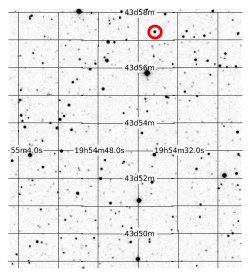Kepler-186
| Observation data Epoch J2000.0 Equinox J2000.0 (ICRS) |
|
|---|---|
| Constellation | Cygnus |
| Right ascension | 19h 54m 36.651s |
| Declination | +43° 57′ 18.06″ |
| Apparent magnitude (V) | ~+15.65 |
| Characteristics | |
| Spectral type | M1V |
| Details | |
| Mass | 0.544 ± 0.02 M☉ |
| Radius | 0.523 ± 0.02 R☉ |
| Temperature | 3755 ± 90 K |
| Metallicity [Fe/H] | −0.26 ± 0.12 dex |
| Age | 4.0 ± 0.6 Gyr |
| Other designations | |
Kepler-186 is a main-sequence M1-type dwarf star, located 151 ± 18 parsecs (492 ± 59 light years) away in the constellation of Cygnus. The star is slightly cooler than the sun, with roughly half its metallicity. It is known to have five planets, including the first Earth-sized world discovered in the habitable zone: Kepler-186f. The star hosts four other planets discovered so far, though Kepler-186 b, c, and d are too close, but e is near the habitable zone's inner edge.
A number of previously unknown measurements of the star are known. In the infrared/microwave EM spectrum its H band magnitude is 11.605, J band magnitude is 12.473, and its K band magnitude is 11.605. In the visual Photometric system magnitude it is 14.90(R)(towards the red end of the visual spectrum) and 16.40(B)(the blue end of the spectrum) (see also Apparent magnitude.) It is a BY Draconis variable changing brightness slightly, probably from starspots, with a period of 33.695 days.
The star is Red dwarf/M-class bordering on being an Orange dwarf/K-class star, with a mass nearly half that of the Sun's, with a density ~1.59 x 105 kg/m3.
Within two first years of gathered data, the signals of four inner planetary candidates were found. Discussion of planets in the system was taking place in August and November 2013. In February 2014, those planets were confirmed through the "verification by multiplicity" method. The fifth outermost candidate was confirmed in the same manner in April 2014. The possibility that the signals in the light curve of the star were actually from something else has been ruled out by an investigation with the W. M. Keck and Gemini Observatories, using speckle imaging and adaptive optics techniques, which, while unable to resolve the planets, were able to rule out other possibilities than the system of planets.
...
Wikipedia

